To grow Excelsa coffee, start by selecting a warm, humid location with well-draining, nutrient-rich volcanic soil. This plant thrives in temperatures between 68°F and 77°F at elevations of 1,000 to 3,000 feet. Prepare the ground by enriching the soil with organic compost, and guarantee proper spacing of 8-10 feet for healthy growth. Regularly water the plants and apply nitrogen-rich fertilizers. Monitor for pests and diseases, pruning annually to promote airflow. Harvest ripe cherries, characterized by bright red color, guaranteeing careful processing post-harvest for peak flavor. There’s much more you can explore to perfect your skills and enhance your yield.
Why Grow Excelsa Coffee?

Excelsa coffee offers a unique opportunity for growers looking to diversify their crops and stand out in the market. This lesser-known variety stands apart with its distinct flavor diversity, featuring tart, fruity, and dark notes that can attract discerning coffee consumers.
By growing Excelsa, you can tap into a niche market that appreciates the unique profiles this coffee delivers.
One of the primary Excelsa benefits is its resilience in various growing conditions. This adaptability makes it appealing for farmers in tropical regions, allowing them to cultivate a crop that thrives where others may struggle.
As a grower, you can enhance your portfolio and potentially increase your income by offering something different from conventional Arabica or Robusta coffees.
Additionally, the growing interest in specialty coffees means that more consumers are seeking unique flavors, making Excelsa a valuable addition to your offerings.
By focusing on this distinctive variety, you can position yourself as a forward-thinking grower, meeting the evolving tastes of coffee lovers.
What Are the Ideal Growing Conditions for Excelsa Coffee?
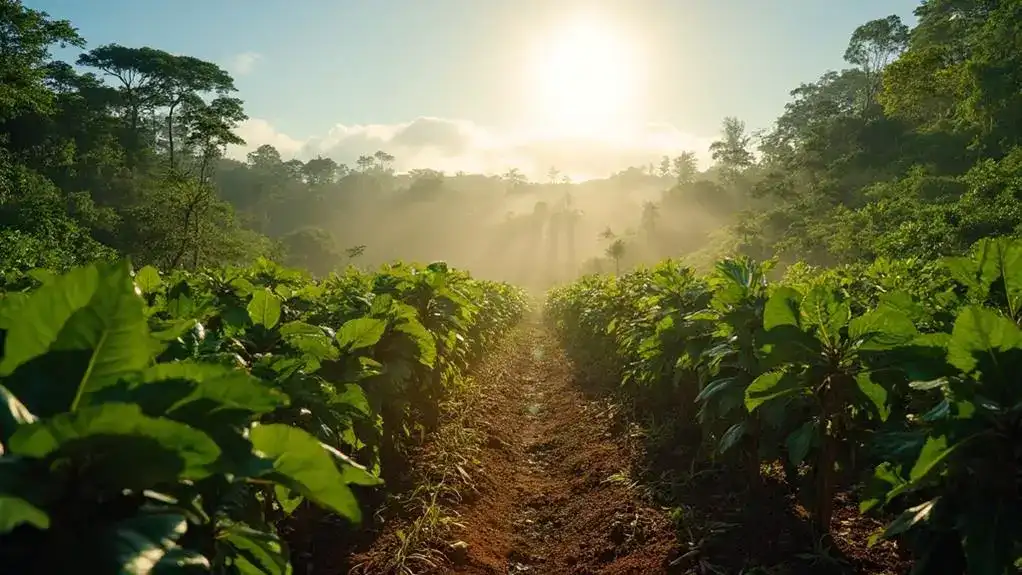
To grow Excelsa coffee successfully, you need to understand its ideal growing conditions, which include both climate and soil requirements.
This unique coffee variety thrives in warm, humid tropical climates and prefers well-draining, nutrient-rich soil.
Ensuring these conditions can lead to healthier plants and better flavor development in your coffee beans.
Climate Requirements
To successfully grow Excelsa coffee, you need to pay attention to its climate requirements. This variety thrives in specific temperature, humidity, elevation, and latitude conditions that mimic its natural habitat.
Here are the key factors to take into account:
- Temperature: Ideal range is 68°F to 77°F.
- Humidity: High humidity levels are essential for growth.
- Elevation: Best between 1,000 to 3,000 feet above sea level.
- Latitude: Thrives in tropical regions close to the equator.
Temperature and Humidity
When growing Excelsa coffee, the right temperature and humidity are essential for ideal development. Aim for temperatures between 68°F and 77°F, coupled with high humidity to promote healthy growth. These conditions help enhance the unique Excelsa flavor, making it a delightful choice for coffee cultivation.
| Temperature Range | Humidity Level | Ideal Conditions |
|---|---|---|
| 68°F – 77°F | 60% – 80% | Warm and humid climate |
Elevation and Latitude
Excelsa coffee thrives best at elevations between 1,000 and 3,000 feet above sea level, where cooler temperatures and consistent weather patterns contribute to the development of its unique flavor characteristics. The elevation impact and latitude effects play vital roles in its growth.
| Elevation (ft) | Flavor Development | Latitude Effects |
|---|---|---|
| 1,000 – 2,000 | Mild flavors | Less acidity |
| 2,000 – 3,000 | Rich flavors | More complexity |
| Above 3,000 | Over-acidity | Limited growth |
Soil Requirements
When growing Excelsa coffee, the right soil is essential for healthy plants and ideal yields.
You’ll need to take into account factors like soil composition, pH levels, and drainage to create the best environment for your coffee.
Here are some key points to keep in mind:
- Soil Composition: Excelsa thrives in volcanic soil rich in nutrients, especially nitrogen.
- pH Levels: Aim for a soil pH between 6 and 6.5 for best growth.
- Fertility: Regularly enrich the soil with organic compost and fertilizers to maintain fertility.
- Drainage: Guarantee proper drainage to prevent waterlogging and root rot, while keeping the soil moist.
Soil Composition
Rich, volcanic soil is essential for cultivating Excelsa coffee, as it provides the vital nutrients these plants need to thrive. To enhance soil nutrition, consider adding organic amendments. Below is a simple table outlining key components for ideal soil composition.
| Component | Purpose |
|---|---|
| Nitrogen | Promotes leaf growth |
| Phosphorus | Supports root development |
| Potassium | Enhances overall health |
| Organic Matter | Improves soil structure |
| Drainage Material | Prevents waterlogging |
pH Levels and Fertility
Maintaining the right pH levels and soil fertility is essential for growing Excelsa coffee successfully. The ideal pH range is between 6 and 6.5. Regular pH testing helps guarantee your soil stays within this range, while soil amendments like organic compost can enhance fertility.
| Aspect | Recommendation |
|---|---|
| pH Level | 6 to 6.5 |
| Fertility | Use organic compost |
| Testing Frequency | Every 3-6 months |
Drainage and Moisture Control
How can you assure proper drainage and moisture control for your Excelsa coffee plants?
Employing effective drainage techniques is key. Consider these tips:
- Use well-draining soil to prevent waterlogging.
- Incorporate organic matter to enhance moisture retention.
- Implement raised beds to improve drainage.
- Monitor irrigation carefully to avoid over-saturation.
These practices assure your plants thrive without the risk of root rot.
How to Prepare for Growing Excelsa Coffee
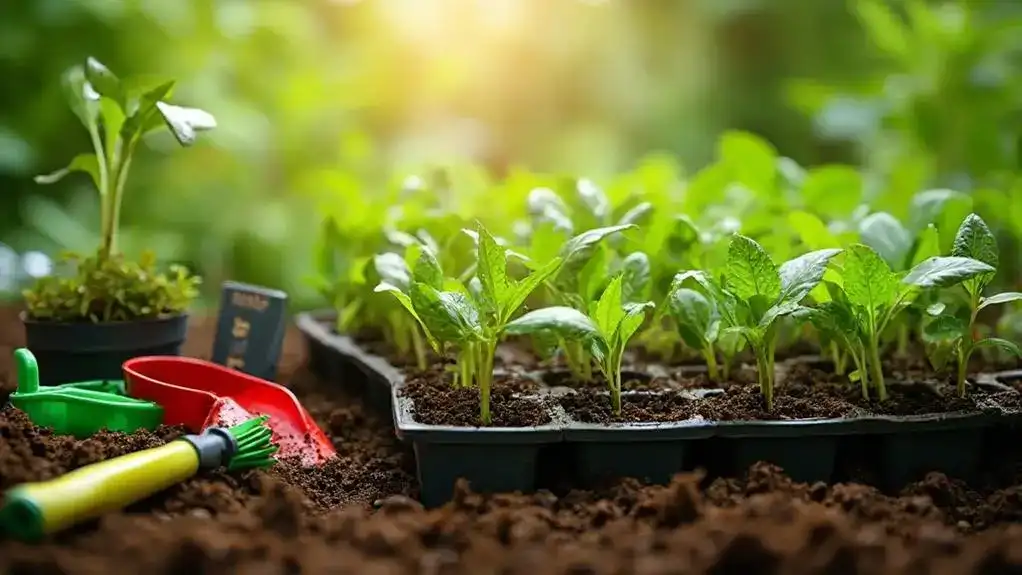
To prepare for growing Excelsa coffee, you need to choose the right location and source quality beans.
Look for a spot that offers a favorable microclimate and soil conditions, ideally with ample sunlight and protection from harsh winds.
Additionally, finding reputable suppliers for your Excelsa coffee seeds or plants guarantees you start with healthy and genetically pure specimens.
Choosing the Right Location
When choosing the right location for growing Excelsa coffee, understanding the terroir is essential.
This includes evaluating the soil, climate, and topography to guarantee they align with the plant’s needs.
Additionally, consider micro-climate factors like sunlight exposure and wind protection, as these can greatly impact your coffee’s growth and quality.
Understanding Terroir
Understanding the terroir is essential for cultivating Excelsa coffee successfully, as it encompasses the unique combination of soil, climate, and topography that influences the coffee’s flavor.
The terroir significance lies in how these factors work together to shape the characteristics of your coffee.
Micro-climate Considerations
Micro-climate factors can greatly influence the growth of Excelsa coffee, making it essential to select a location that provides the right conditions.
Consider these aspects for ideal growth:
- Ample sunlight exposure
- Consistent humidity levels
- Protection from strong winds
- Proximity to water sources
These micro climate benefits will help guarantee your Excelsa coffee plants thrive and produce high-quality beans.
Sourcing Excelsa Coffee Beans
When you’re ready to start growing Excelsa coffee, sourcing quality seeds or plants is key. You can find reputable suppliers and co-op groups that specialize in Excelsa, ensuring healthy and genetically pure plants.
Here are some tips to help you in your search:
- Look for specialized nurseries that focus on coffee varieties.
- Check for co-op groups in regions known for Excelsa, like the Philippines.
- Ask for recommendations from local coffee growers or online forums.
- Verify the quality and health of the plants before making a purchase.
Where to Buy Seeds or Plants
Finding quality Excelsa coffee seeds or plants is essential for successful cultivation, and fortunately, there are several reliable sources available.
Consider these options for seed sourcing and planting techniques:
- Specialized nurseries
- Local agricultural co-ops
- Online garden retailers
- Coffee-growing associations
These sources typically provide healthy plants or seeds, ensuring you start your Excelsa coffee journey on the right foot.
Contacting Co-op Groups in the Philippines
Contacting co-op groups in the Philippines can be a significant step in sourcing quality Excelsa coffee beans.
Here are some co-op benefits and sourcing strategies to contemplate:
- Access to high-quality seeds.
- Shared knowledge on cultivation techniques.
- Networking with experienced growers.
- Potential for collective marketing efforts.
These connections can help you establish a strong foundation for successfully growing Excelsa coffee.
How to Plant Excelsa Coffee

When you’re ready to plant Excelsa coffee, you have two main methods to choose from: seeds or cuttings. Each approach has its benefits, and understanding best practices will help guarantee your plants thrive.
Here are some key points to take into account:
- Seeds vs. Cuttings: Seeds offer genetic variation, while cuttings mature faster.
- Soil Preparation: Confirm the soil is rich and well-draining for ideal growth.
- Spacing: Plant your seedlings 8-10 feet apart to allow for root expansion.
- Germination: Pre-soak seeds and provide a controlled environment for successful germination.
Planting from Seeds vs. Cuttings
Whether you choose to grow Excelsa coffee from seeds or cuttings depends on your goals and available resources. Each method has its advantages, so understanding them will help you make an informed decision.
- Seed Viability: Growing from seeds allows for genetic variation and the potential for more resilient plants. However, verify the seeds you select have high viability rates to increase your chances of successful germination.
- Cutting Techniques: If you opt for cuttings, you can maintain specific plant characteristics. This method often leads to faster maturity since cuttings are already part of a mature plant.
- Time Investment: Seeds typically require more time to grow from germination to a mature plant, while cuttings can establish roots more quickly and may produce fruit sooner.
- Resource Availability: Consider what resources you have. Seeds might be easier to source, while cuttings may require guidance on proper techniques to verify success.
Ultimately, your choice should align with your growing conditions, goals, and the level of commitment you’re prepared to invest in cultivating Excelsa coffee.
Best Practices for Planting
When planting Excelsa coffee, getting the seed preparation and transplanting process right is essential for healthy growth. Start by making sure your seeds are well-prepared for germination, then carefully transplant your seedlings with adequate spacing.
Here are some best practices to follow:
- Pre-soak seeds to enhance germination rates.
- Use a controlled environment for initial planting.
- Space seedlings 8-10 feet apart for ideal growth.
- Monitor moisture levels to guarantee healthy root development.
Seed Preparation and Germination
Proper seed preparation and germination are essential steps in successfully growing Excelsa coffee.
Start with these best practices:
- Source high-quality seeds from reputable suppliers.
- Pre-soak seeds to enhance germination rates.
- Use appropriate germination techniques, such as maintaining warm temperatures and humidity.
- Plant seeds in well-draining soil to prevent waterlogging.
Following these steps will set a solid foundation for your Excelsa coffee plants.
Transplanting and Spacing
Transplanting Excelsa coffee seedlings requires careful attention to spacing to secure healthy growth and ideal air circulation.
To assure success, follow these planting techniques and growth strategies:
- Space seedlings 8-10 feet apart.
- Choose a well-draining site.
- Transplant during cooler hours.
- Water thoroughly after planting.
These practices will promote robust growth and enhance the overall health of your Excelsa coffee plants.
How to Care for and Maintain Excelsa Coffee Plants
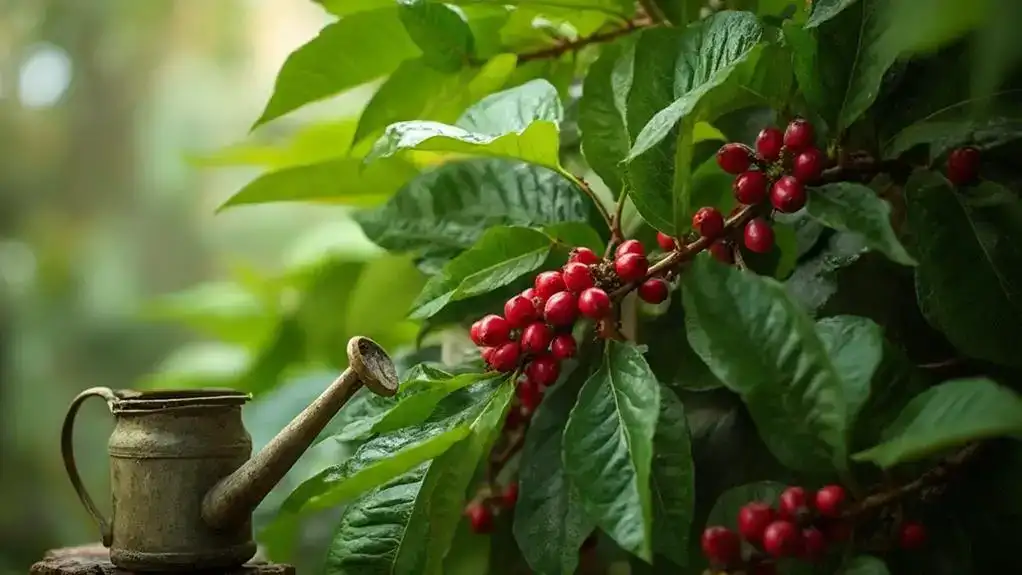
To keep your Excelsa coffee plants thriving, you’ll need to focus on a few key care practices. Regular watering, proper fertilization, pest management, and annual pruning are essential to guarantee healthy growth and high yield.
Here are some important points to take into account:
- Watering and Fertilization: Use drip irrigation for consistent moisture and apply organic fertilizers rich in nitrogen and potassium.
- Pest and Disease Management: Monitor plants regularly and utilize natural pest control methods to prevent infestations.
- Pruning and Shaping: Prune annually to promote airflow and remove any dead or diseased branches.
- Growth Monitoring: Keep an eye on plant health to adjust care techniques as needed for peak results.
Watering and Fertilization
To keep your Excelsa coffee plants thriving, you need to focus on effective watering and fertilization strategies.
Utilizing the right irrigation techniques and selecting appropriate fertilizers will guarantee your plants receive the nutrients they need without over-saturating the soil.
Here are some key points to take into account:
- Irrigation Techniques: Drip irrigation is ideal for consistent moisture control.
- Types of Fertilizers: Opt for organic fertilizers rich in nitrogen, potassium, and phosphorus.
- Watering Frequency: Water regularly but adjust based on rainfall and soil moisture.
- Fertilization Schedule: Apply fertilizers according to the plant’s growth stages for peak results.
Irrigation Techniques
When it comes to irrigation techniques for Excelsa coffee, effective moisture management is essential for healthy plant development.
Here are some key irrigation methods to take into account:
- Use drip irrigation to maintain consistent moisture levels.
- Water early in the morning to reduce evaporation.
- Monitor soil moisture regularly.
- Adjust irrigation based on rainfall to prevent over-saturation.
These practices will help guarantee thriving plants.
Types of Fertilizers to Use
Choosing the right fertilizers is essential for maximizing the growth and yield of Excelsa coffee plants. Regular fertilizer application helps prevent nutrient deficiencies that can hinder development.
Consider these types:
- Organic compost
- Nitrogen-rich fertilizers
- Potassium and phosphorus blends
- Slow-release granular fertilizers
Using these options guarantees your plants receive balanced nutrition throughout their growth stages, promoting healthy development and robust yields.
Pest and Disease Management
Effective pest and disease management is vital for maintaining a healthy Excelsa coffee plantation. By regularly monitoring your plants and implementing effective pest control methods, you can greatly reduce the risk of infestations and diseases that threaten your yield.
Here are four key strategies to take into account:
- Natural Predators: Introduce beneficial insects, such as ladybugs and lacewings, to help control pest populations naturally. They can effectively reduce aphids and other harmful pests.
- Companion Planting: Planting certain crops alongside your Excelsa coffee can deter pests. For example, marigolds can repel nematodes and other harmful insects.
- Regular Inspections: Frequently check your plants for signs of disease, such as yellowing leaves or unusual spots. Early detection is critical for effective disease prevention strategies.
- Organic Treatments: Utilize organic pesticides and fungicides as a preventive measure. Neem oil and diatomaceous earth are effective against various pests and diseases without harming beneficial organisms.
Pruning and Shaping the Plants
To maintain healthy Excelsa coffee plants, regular pruning and shaping are essential practices. These actions promote airflow, remove dead or diseased branches, and encourage new growth, ultimately leading to a more productive plant.
Here are some effective pruning techniques and shaping methods you can apply:
- Annual Pruning: Aim to prune your plants at the beginning of the growing season. This helps in shaping the plant and encourages robust growth.
- Selective Cutting: Remove only the branches that are dead or weak, allowing the healthier branches to thrive. This selective approach maintains the plant’s overall structure.
- Shaping for Airflow: Confirm that the center of the plant remains open to promote airflow, reducing the risk of fungal diseases. Trim back any overcrowded branches.
- Height Control: If your Excelsa plants grow too tall, consider topping them off. This encourages lateral growth and makes harvesting easier.
How to Harvest Excelsa Coffee
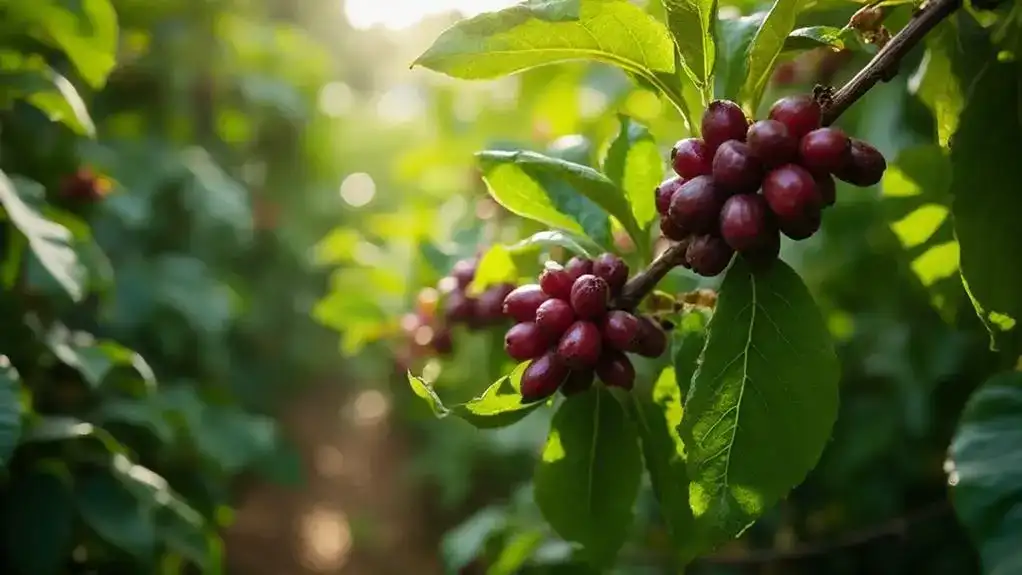
When it comes to harvesting Excelsa coffee, timing is everything.
You’ll need to identify ripe cherries, which should be a bright deep red, to guarantee the best flavor.
Using proper harvesting techniques, such as hand-picking, can help you select only the finest cherries for your coffee.
Identifying Ripe Cherries
Ripe Excelsa coffee cherries are essential for achieving the best flavor in your brew, and knowing how to identify them can make all the difference. To guarantee you harvest at the right time, pay attention to the cherry color and texture.
Here are four key indicators to help you identify ripe cherries:
- Color: Look for cherries that have turned a bright, deep red. This vivid color indicates they’re ripe and ready to be picked.
- Firmness: Gently squeeze a cherry. It should feel firm yet slightly soft, signifying it’s at peak ripeness.
- Glossiness: Ripe cherries often have a shiny appearance due to the natural oils on their skin. This sheen is a good sign of freshness.
- Time of Year: Harvest timing is critical. Typically, Excelsa cherries ripen during the dry season, so monitor your plants closely as they approach this period.
Harvesting Techniques
When it comes to harvesting Excelsa coffee, choosing the right technique can notably affect the quality of your beans.
You’ll need to take into account whether manual or mechanical harvesting suits your needs and the best time for picking those cherries.
Here are some key points to keep in mind:
- Manual vs. Mechanical Harvesting – Manual picking allows for selective harvesting of only ripe cherries, while mechanical methods are faster but may include unripe or damaged ones.
- Best Harvest Time – Aim to harvest during the dry season when cherries achieve their peak ripeness.
- Ripe Cherry Indicators – Look for a bright deep red color to ascertain cherries are ready for picking.
- Post-Harvest Considerations – Handle the cherries carefully to maintain their quality for processing.
Manual vs. Mechanical Harvesting
Harvesting Excelsa coffee can be approached in two primary ways: manual and mechanical methods. Manual harvesting, though labor-intensive, guarantees only ripe cherries are selected, enhancing quality. In contrast, mechanical harvesting is faster but may result in unripe or damaged cherries. Understanding these differences helps you choose the best method for your needs.
| Harvesting Method | Pros and Cons |
|---|---|
| Manual Harvesting | High quality, selective picking |
| Mechanical Harvesting | Faster, can include unripe cherries |
Optimal Harvest Time
Timing plays a significant role in the quality of your Excelsa coffee. For ideal harvest timing, consider these key factors to enhance cherry quality:
- Harvest during the dry season.
- Pick cherries when they’re a deep red color.
- Avoid over-ripening by checking daily.
- Use hand-picking for selective harvesting.
These practices guarantee you capture the best flavors and aromas in your Excelsa coffee.
How to Process Excelsa Coffee After Harvest
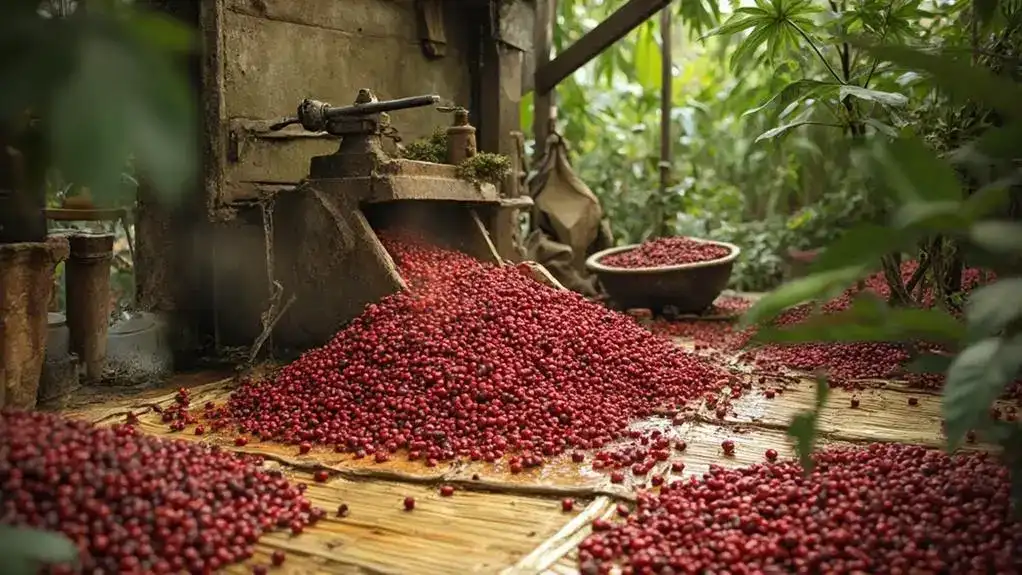
After harvesting your Excelsa coffee cherries, the next critical step is processing them properly to enhance their flavor.
You’ll need to focus on drying and milling the beans to prepare them for roasting, which can greatly affect the final taste.
Additionally, storing the processed beans correctly in a cool, dry place will help maintain their quality until you’re ready to brew.
Drying and Milling the Beans
Once you’ve picked the ripe Excelsa coffee cherries, you’ll need to focus on drying and milling them to release their full flavor potential. Proper processing is vital for flavor development, so pay close attention to these steps:
- Drying Method: You can dry the cherries naturally in the sun or use mechanical dryers. Natural drying typically takes longer but can enhance sweetness.
- Drying Duration: Aim to dry the cherries until they reach about 12% moisture content. This can take several days, depending on weather conditions and drying method.
- Milling Process: Once dried, the cherries should be hulled to remove the outer parchment layer. This process prepares the beans for roasting and is essential for achieving the desired flavor profile.
- Quality Control: After milling, inspect the beans for defects or inconsistencies. High-quality beans will yield a better cup of coffee, so confirm that only the best make it through to the next stages.
Storage of Excelsa Coffee Beans
Properly storing Excelsa coffee beans is essential for preserving their flavor and quality until you’re ready to roast them.
Using effective storage techniques can greatly enhance the longevity of your beans and maintain their unique taste. Here are four tips to guarantee ideal flavor preservation:
1. Choose an Airtight Container: Store your beans in an airtight container to prevent exposure to air, which can lead to oxidation and flavor loss.
2. Control Temperature: Keep your storage area cool and dark, ideally between 60°F to 70°F.
Avoid placing beans near heat sources or in direct sunlight.
3. Limit Moisture: Humidity can adversely affect the beans, leading to mold and spoilage.
Ensure your storage space is dry, as moisture is a considerable concern.
4. Avoid Frequent Opening: Try to minimize how often you open the storage container.
Each exposure to air can compromise the beans’ quality over time.
What is the Commercial Potential of Excelsa Coffee?
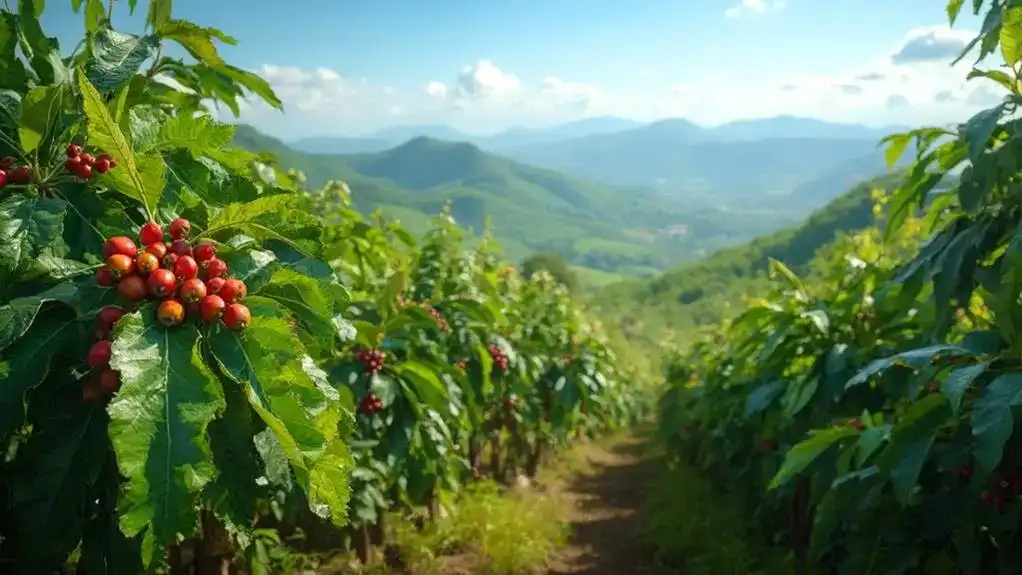
Excelsa coffee presents a unique commercial opportunity due to its niche market and growing demand among specialty coffee buyers.
While it may not match the reputation of Arabica, its distinct flavor profile can attract a dedicated consumer base willing to explore something different.
Understanding the supply dynamics and quality perceptions will help you assess whether growing Excelsa coffee is a viable venture for your operation.
Supply and Demand Insights
How does the supply and demand landscape shape the future of Excelsa coffee? The commercial potential for Excelsa coffee lies in its unique position within the coffee market. As demand for specialty coffee grows, many consumers are looking for distinct flavors beyond traditional varieties like Arabica and Robusta. This shift in market trends can create opportunities for growers who cultivate Excelsa.
Currently, the supply chain for Excelsa coffee is limited, primarily due to its niche status and the specific growing conditions it requires. While Excelsa coffee is often overshadowed by more popular varieties, the increasing interest among coffee enthusiasts offers a chance for growers to tap into a dedicated consumer base.
As you consider entering this market, keep in mind that establishing relationships with specialty coffee buyers can enhance your access to a broader audience. Understanding these dynamics can help you make informed decisions about cultivating Excelsa coffee.
Quality Considerations
When evaluating the commercial potential of Excelsa coffee, it’s important to assess how it stacks up against other varieties.
Understanding its unique marketability can help you decide if it’s worth growing. Here are a few key points to take into account:
- Comparison with Arabica and Robusta in flavor and demand.
- Niche market appeal among specialty coffee enthusiasts.
- Potential profitability due to limited supply.
- Opportunities for branding and unique product offerings.
Comparison with Other Coffee Varieties
Exploring the commercial potential of Excelsa coffee requires a clear understanding of how it stacks up against other coffee varieties. While Excelsa offers a unique flavor profile that enhances coffee sustainability, its market presence remains niche. Here’s a comparison with Arabica and Robusta:
| Variety | Flavor Profile | Commercial Viability |
|---|---|---|
| Excelsa | Tart, fruity, dark | Niche |
| Arabica | Sweet, floral | High |
| Robusta | Bold, earthy | Moderate |
Marketability of Excelsa Coffee
The marketability of Excelsa coffee hinges on its distinctive flavor profile and growing interest among specialty coffee enthusiasts.
As market trends shift towards unique and diverse coffee options, consumer preferences increasingly favor Excelsa’s tart, fruity notes.
While often perceived as lower-grade, its unique characteristics can attract dedicated buyers, positioning Excelsa coffee as a viable option in the evolving specialty coffee market.
How to Continuously Improve Your Excelsa Coffee Growing Skills
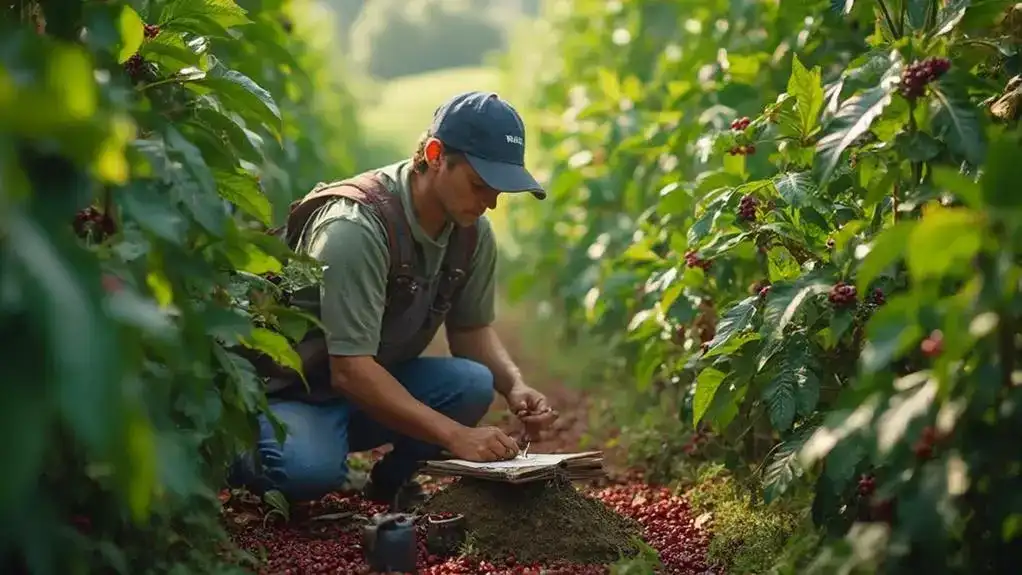
To continuously improve your Excelsa coffee growing skills, engage actively with the coffee-growing community.
Share your experiences and learn from others by documenting your journey, whether through social media or local meetups.
This exchange of knowledge can provide valuable insights and help you refine your cultivation techniques over time.
Engaging with the Coffee Growing Community
How can you enhance your Excelsa coffee growing skills? Engaging with the coffee growing community is a great way to continuously improve. You’ll find support, resources, and shared experiences that can inform your journey.
Here are four practical steps to get started:
- Attend Community Events: Participate in local coffee festivals, workshops, or farmer’s markets to meet other growers and enthusiasts. These gatherings often feature expert talks and hands-on demonstrations.
- Join Online Forums: Look for social media groups or forums dedicated to coffee cultivation. These platforms are excellent for asking questions, sharing progress, and learning from experienced growers.
- Participate in Knowledge Sharing: Offer your insights and experiences while learning from others. This reciprocal exchange can deepen your understanding and expose you to diverse growing techniques.
- Network with Local Farmers: Connect with nearby coffee growers to exchange tips and best practices. Building relationships can lead to mentorship opportunities and collaborative projects.
Documenting and Sharing Your Journey
Documenting your journey in growing Excelsa coffee not only helps you track your progress but also allows you to refine your techniques over time.
By keeping records, you can identify what works best in your specific environment and adapt your methods accordingly. Sharing your experiences with others can enhance your learning and contribute to the coffee-growing community.
Here are some effective ways to document and share your journey:
- Maintain a Grower’s Journal: Write down your observations, including planting dates, weather conditions, and any changes you make. This will serve as a valuable reference.
- Take Photos: Capture the growth stages of your plants. Visual documentation can be inspiring and helpful for others looking to grow Excelsa coffee.
- Join Online Forums: Engage with fellow coffee enthusiasts on social media or dedicated platforms. Sharing tips and asking questions can lead to valuable insights.
- Create a Blog or Vlog: Consider starting a blog or YouTube channel to share your journey. This not only documents your progress but also connects you with a broader audience interested in growing tips.
Conclusion
Growing Excelsa coffee can be a rewarding endeavor, whether you’re a novice or an experienced gardener. By focusing on the right conditions and proper care, you’ll cultivate a unique coffee variety that stands out in flavor and resilience. As the saying goes, “You reap what you sow.” With dedication and attention to detail, you’ll not only enjoy the fruits of your labor but also enhance your skills in coffee cultivation. Start your Excelsa journey today!

